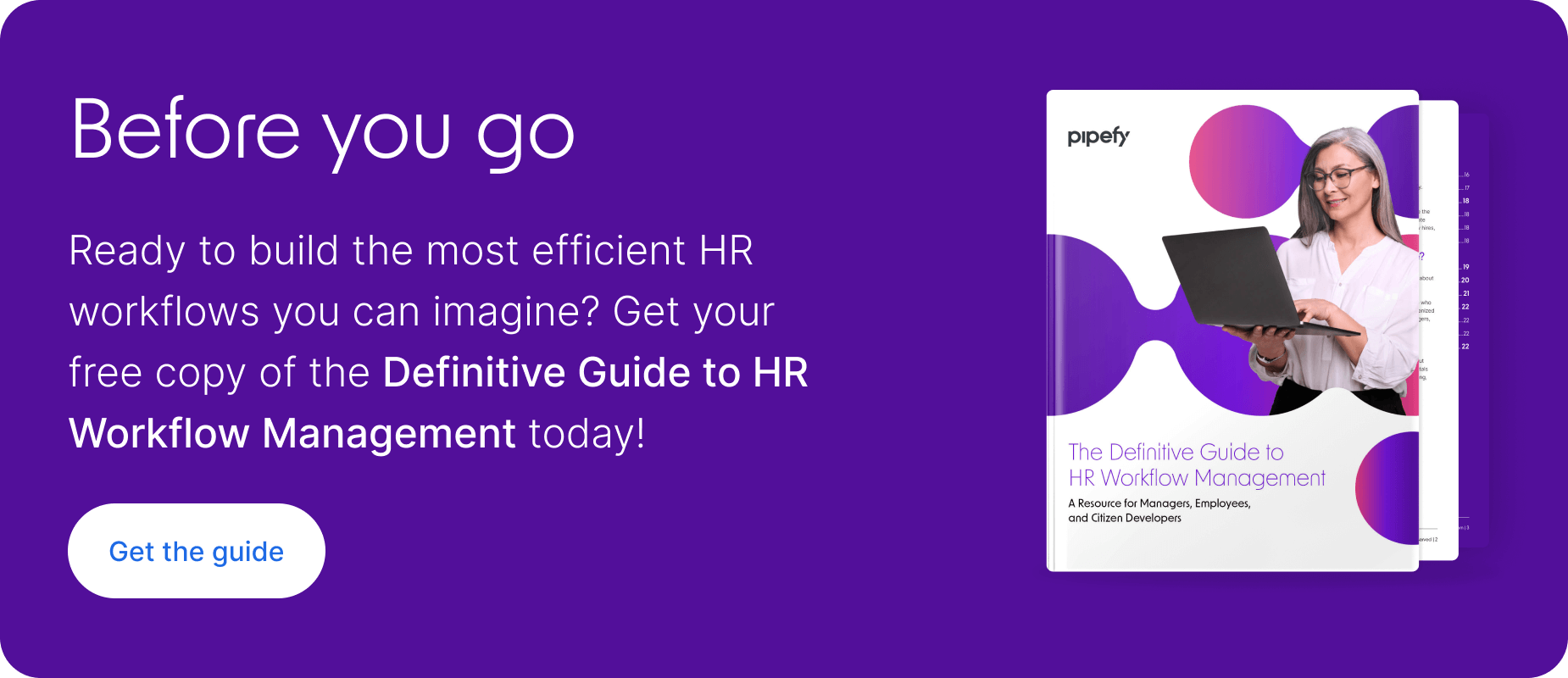
Statistics are loud and clear: employment management has a direct correlation with employee engagement — and it’s foundational to a profitable and successful business.
Studies show that financial rewards, team leadership, and work support all impact an employee’s ability to do their best work. Performance management is a key component of employee management, too. In fact, employees are more enthusiastic about their work when they believe their leader can identify their strengths and abilities.
Here’s what you need to know for mastering employee management and how to develop employee potential.
Definitive Guide to HR Workflow ManagementDownload now
What is employee management?
Employee management refers to the organization’s efforts to support the success of its employees and also help them meet the business goals for which they are responsible. It is a function of the company’s HR or People Operations team.
The goal of employee management is to help employees develop their potential and maximize their contributions to organizational success.
Successful employee management consists of recruiting the right employees, building relationships, and establishing a consistent employee management process.
Main employee management areas
There are a wide variety of tasks that fall under employee management, but key activities can be organized into the following categories: selection, monitoring, interacting, rewarding, and correction or disciplining.
Selection
Selection, or recruitment, is the way in which organizations attract, screen, and choose top talent for their teams. Selection is all about ensuring alignment with the mission, vision, and core values of the organization. Selection includes posting role requisitions, approving requisitions, collecting applications, screening candidates, interviewing candidates, making and negotiating offers, and preboarding.
Monitoring
Monitoring — also known as performance management — includes providing employees with the tools, resources, and feedback they need in order to perform at the top of their skill sets. It includes conducting one-on-one check-ins, introductory evaluations soon after the employee starts, and checking in periodically over the course of their employment to provide real-time feedback to obtain performance insights.
Interacting
This happens every day between employees and their leaders. It’s how leaders communicate organizational performance and reinforce policies, procedures, and core values. This aspect of employee management also includes providing real-time feedback and getting to know their employees as whole people. Interacting happens through email, face-to-face interactions, team meetings, and more.
Rewarding
Rewarding refers to the ways in which we reward excellence in the workplace. This includes awards, recognition, promotions, bonuses, and more. Rewarding can also include the ways in which employees recognize one another for stepping up, helping out, and contributing to the success of the team.
Disciplining
Finally, correction or disciplining refers to the ways in which we correct behavior or conduct that has veered away from company standards of conduct. Disciplining might include coaching, verbal warnings, improvement plans, written warnings, final warnings, suspensions, or even terminations. These processes typically require a combination of centralized relevant documentation and face-to-face meetings whenever possible.
Employee management benefits
Employee management means investing in team members and nurturing relationships between employees and the company. Organizations with an employee management program that offers employees the resources and support they need to perform well realize a multitude of benefits, including:
Better role alignment
Employees understand exactly what’s expected of them. They don’t receive mixed messages or struggle to meet undefined expectations because their role and expectations are clearly defined.
A more diverse and inclusive workplace
Seeking and hiring qualified candidates that align with business values leads to a more dedicated, diverse, and inclusive workforce because it attracts people who are most likely to stay, succeed, and enjoy the work.
Opportunities for employee development
Candid and useful feedback helps employees realize their full potential and avoid behaviors or performance issues that hinder professional growth.
Higher employee engagement
Employees have a strong desire to perform and take accountability for the organization’s performance or goals, so they show up fully every day and do their best work whether a leader is monitoring them or not.
Higher job satisfaction
When employees feel appreciated and valued, they are more likely to stay, to share word of mouth referrals, and to represent the organization positively. As a result, turnover is decreased, retention is increased, and productivity goes up.
Better business results
Client satisfaction improves because employees are more engaged and satisfied with their work.
6 employee management tips
The most successful leaders integrate mission, vision, and core values into their daily leadership and interactions, and connect with their employees regularly. They see their employees as whole people and are invested in their growth and success.
1. Define expectations
Nothing impedes employee success more than undefined expectations. Leaders can support the success of their team members by providing clear expectations from the moment they’re hired. Employees need to know how often to communicate with their leader and, specifically, what they’re expected to deliver in their first week, first month, and first quarter.
2. Establish priorities
Set clear priorities for new employees as they begin their careers in the organization. It’s unlikely that an employee will develop proficiency overnight, so be sure think through questions like:
- What should they focus on first?
- Which proficiencies can they expect to have in the first week, month, quarter?
Share those priorities with new employees so they have clear goals and know where to aim as they settle into their roles.
3. Conduct performance reviews
Employees are hungry for feedback on their performance. They need to know where they’ve been the most successful and where they should focus their efforts on growth in the next weeks and months. Conduct regular performance reviews to ensure these transparent conversations are happening as often as recommended or required.
4. Communicate clearly
Ask new employees what kind of communication they prefer to determine whether to communicate or interact in-person, via phone, email, or video call, or another method. Ask questions like:
- What’s going well?
- Do you have the tools and resources you need to perform your duties?
- What can I do to better support you?
- Do you feel welcomed and integrated into the team?
- Do you understand what’s expected of you?
- Where do you see yourself in one year? Five years?
Communicate frequently and clearly, and invite them to ask questions as well to ensure that communication flows both ways.
5. Improve employee engagement
Engage employees by:
- Keeping mission, vision, and core values at the forefront.
- Learning more about their goals and helping them see their potential within the organization.
- Encouraging opportunities for teambuilding and friendship.
- Ensuring competitive pay and benefits programs.
- Providing flexibility whenever possible to allow for optimal work life balance.
6. Be an example
Employees look to their leaders to model the behaviors that are expected of them. The single most important step leaders can take is to live out the mission, vision, and core values of the organization in their daily interactions.
How to manage a difficult employee
It may be intimidating to challenge employees that may not be performing well or reflecting company values, but calling those employees to greatness is a critical component of successful leadership.
Create an action plan
Having honest conversations is easiest with clear processes, structured tools, and ample training to equip managers with clear policies and designated resources. Working with business or HR leaders to create a clear and standardized action plan helps managers feel more confident when managing difficult employees and ensures that managers are supported so employees are best supported as well.
Provide feedback
Employees who aren’t meeting expectations may benefit from candid and transparent feedback about their performance. When providing feedback, follow this feedback framework:
- Refer to company policies or performance standards that are well-established and easily referenced.
- Be clear about what behaviors are and aren’t meeting expectations.
- Diffuse tension by providing constructive feedback in a way that offers an opportunity for improvement.
Set expectations
Provide challenging employees with clear assignments, due dates, and measures of success. Make sure the employee knows what they will deliver if they’ve successfully met your expectations.
Monitor performance
Keep an eye on employee performance and hold regular conversations with employees who are struggling. Take time to celebrate successes and wins, and be sure to provide feedback in real time when a behavior or skill doesn’t meet your expectations.
Provide the employee with clear action items to drive improvement. Work with them to better understand and develop an action plan for what employees should do in order to improve their short- and long-term performance. Schedule a follow-up meeting to re-evaluate and, if all goes according to their improvement plan, reassure the employee that their behavior and performance is back on track.
Key tools for employee management
Using the right tools can help you standardize and improve employee management across your organization. Some tools — such as HR process automation — offer teams a range of features and customization options to create an employee management process that works for them.
Employee scheduling
Employee scheduling can be complicated and time-consuming, especially for leaders managing many direct reports. Scheduling software can automate not only scheduling, but shift changes, requests for time off, and timekeeping metrics for convenience and maximized productivity.
Task management
Task management modules can help you streamline due dates for common HR tasks: performance evaluations, check-in conversations, and more. You can transition from creating manual calendar reminders to a visually appealing dashboard with system alerts when deadlines have passed.
HR forms and self-service portal
HR ticketing system can automate employee forms and give employees access to change their own address, direct deposit account, phone number, and more without paper and without involving an HR business partner except in an approval role for the workflows you designate as requiring approval.
Employee self-service portals alleviate managers, directors, and HRBPs of transactional work so they can focus on the transformational work necessary to drive business results.
Employee directory and database
Employee directory functionality gives employees the ability to look up coworkers, better understand their relationship with the organization, and contact them at their work email address or extension.
Database software allows you to keep all employee data in a single system of record: name, address, dates of service, date of birth, etc. Your HR team and managers can have customized access and never have to dig through paper files to find the important data points they need.
HR automation
HR automation software automates laborious HR processes like filing documents, data entry, and more. This frees up time for HR teams to focus on strategic and transformational work that has more potential to impact the organization in a positive way.
Electronic signatures
Having a system in place that supports electronic signatures makes it possible to move to completely digital forms. This means no more paper files that can get lost, are disorganized, and lead to data entry errors.
Custom HR workflows
Within your HR department, you likely have workflows. Perhaps a manager drafts a final warning, HR reviews and provides feedback or approval, and then the manager delivers it, for example. HR systems allow you to build these customized workflows and then automate them instead of sliding papers under the door and waiting for them to show back up under another.
What is an employee management system?
An employee management software organize information related to employee management. This type of system can help your organization get rid of paper documents, paper files, calendar reminders, and phone calls by automating all aspects of employee management according to organizational policy and procedure as well as industry best practices.
Employee management systems might include:
- Document storage and management (electronic personnel file).
- Workflow automations for approving requests or reviewing candidates.
- Integration with timekeeping and payroll systems.
- Custom forms dashboards for instant, real-time insight into business metrics — like minorities in leadership or employee reasons for leaving — that can be used to improve culture and employee engagement and retention.
Streamline your employee management with Pipefy
If your employee management systems are still being managed and run via spreadsheets, various disconnected softwares, or across paper-based processes, you may be experiencing common challenges like incorrect or misplaced employee information, siloed communication with collaborators, and delays in processing or approving requests due to time-consuming rework and repetitive or redundant tasks. This ultimately takes away time and resources from the people that matter most: employees.
With Pipefy’s low-code process automation and management solution, streamline and automate employee management processes for maximum engagement, productivity, and efficiency.






